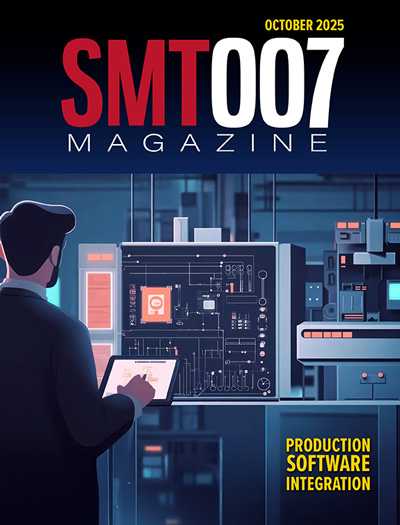-

- News
- Books
Featured Books
- smt007 Magazine
Latest Issues
Current Issue
Spotlight on Mexico
Mexico isn’t just part of the electronics manufacturing conversation—it’s leading it. From growing investments to cross-border collaborations, Mexico is fast becoming the center of electronics in North America. This issue includes bilingual content, with all feature articles available in both English and Spanish.

Production Software Integration
EMS companies need advanced software systems to thrive and compete. But these systems require significant effort to integrate and deploy. What is the reality, and how can we make it easier for everyone?

Spotlight on India
We invite you on a virtual tour of India’s thriving ecosystem, guided by the Global Electronics Association’s India office staff, who share their insights into the region’s growth and opportunities.
- Articles
Article Highlights
- Columns
- Links
- Media kit
||| MENU - smt007 Magazine
NAND Flash Prices Begin to Recover in 2Q25 as Production Cuts and Inventory Rebuilding Take Effect
March 26, 2025 | TrendForceEstimated reading time: 2 minutes
TrendForce reports that NAND Flash suppliers began reducing production in the fourth quarter of 2024, and the effects are now starting to show. In anticipation of potential U.S. tariff increases, consumer electronics brands have accelerated production, further driving up demand. Concurrently, inventory restocking is underway across the PC, smartphone, and data center sectors. As a result, NAND Flash prices are expected to stabilize in the second quarter of 2025, with prices for wafers and client SSDs projected to rise.
Client SSD prices to rise 3–8% while enterprise SSD prices to remain flat
After three consecutive quarters of inventory depletion, client SSD demand is rebounding as OEMs resume production early. The upcoming end of Windows 10 support and the launch of new-generation CPUs are expected to drive replacement demand for PCs. Meanwhile, the DeepSeek effect is accelerating the adoption of edge AI, further fueling client SSD demand. With production cuts and supply adjustments gradually restoring balance, client SSD contract prices are projected to rise 3% to 8% QoQ in Q2.
Technologies like DeepSeek have significantly lowered AI model training costs, spurring strong demand for high-performance storage solutions in China. In North America, however, demand is more polarized: server brand orders have been weaker than expected, while CSPs are increasing procurement as NVIDIA’s Blackwell platform begins shipping. Consequently, enterprise SSD orders are expected to see slight QoQ growth in Q2.
On the supply side, some vendors slashed PCIe 4.0 SSD prices by over 20% in Q1 to clear inventory. Suppliers have adjusted capacity to stabilize prices, and some server clients have pulled in orders earlier than planned. As such, enterprise SSD contract prices are expected to hold steady in Q2.
eMMC and UFS prices hold steady as NAND Flash wafer prices to rise 10–15%
TrendForce notes that shipments of smart TVs, tablets, and Chromebooks are expected to rise in Q2. Coupled with a stable demand for mid-to-low-end smartphones in emerging markets and subsidy policies in China, eMMC orders are seeing an uptick.
On the supply side, previous oversupply and price declines drove NAND Flash makers into losses, prompting production cuts to rebalance the market. To return to profitability, suppliers have raised wafer prices for module makers, who in turn are less able to compete with low prices, easing pricing pressure on the original suppliers. As a result, eMMC contract prices are projected to remain flat in Q2.
UFS demand remains stable, supported by high-end smartphones and increasing storage requirements in automotive applications. On the supply side, overall NAND Flash capacity adjustments have reduced UFS availability, and Q2 contract prices are expected to remain unchanged from the previous quarter.
In the NAND Flash wafer market, prices have hit bottom and inventory restocking is underway. Both module makers and OEMs are increasing procurement, while the rebound in enterprise SSD demand is driving interest in high-end wafer products. With reduced wafer supply from production cuts and new pricing strategies for high-layer NAND Flash in response to recovering demand, Q2 NAND Flash wafer contract prices are expected to rise by 10% to 15%.
Testimonial
"We’re proud to call I-Connect007 a trusted partner. Their innovative approach and industry insight made our podcast collaboration a success by connecting us with the right audience and delivering real results."
Julia McCaffrey - NCAB GroupSuggested Items
Off-Season Slowdown and Inventory Pressure Drive Over 20% QoQ Revenue Drop for Top Five NAND Flash Brands in 1Q25
05/29/2025 | TrendForceTrendForce’s latest findings reveal that the top NAND Flash suppliers faced mounting inventory pressure and weakening end-market demand in the first quarter of 2025. Consequently, the industry saw a 15% QoQ decline in ASP and a 7% drop in shipment volume.
Panel Driver IC Price Decline Slows in 1H25; Gold Prices, China Subsidies, and U.S.-China Tariffs Emerge as Key Variables
04/28/2025 | TrendForceTrendForce’s latest investigation finds that China’s subsidy policies and rising concerns over reciprocal tariffs are reshaping brand strategies in the panel market, indirectly influencing price trends for panel driver ICs.
China’s Installation Rush Expected to Drive Up Solar Industry Prices in 2Q25
03/27/2025 | TrendForceTrendForce’s latest findings reveal that government incentives in China are boosting overall solar demand and creating a sense of supply tightness in the PV module market. This surge is expected to trigger a moderate demand peak in March and April 2025, likely pushing prices across the solar value chain higher in the second quarter.
Downstream Inventory Reduction Eases DRAM Price Decline in 2Q25
03/25/2025 | TrendForceTrendForce’s latest findings reveal that U.S. tariff hikes prompted most downstream brands to frontload shipments to 1Q25, accelerating inventory reduction across the memory supply chain.
Weak Consumer Electronics Demand Drives 4Q24 NAND Flash Revenue Down 6.2% QoQ
03/03/2025 | TrendForceTrendForce’s latest research reveals that the NAND Flash market faced downward pressure in 4Q24 as PC and smartphone manufacturers continued inventory clearance efforts, leading to significant supply chain adjustments.


